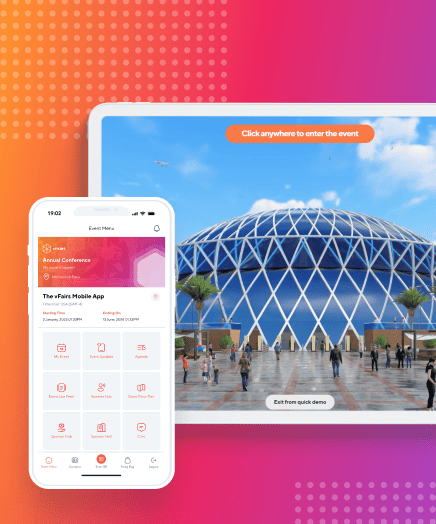Pandemic or no pandemic, it is safe to say that virtual food exhibitions have unlocked perks for organizers, exhibitors, and attendees, in a way they probably couldn’t imagine to relish at a physical food exhibition. A virtual food exhibition acts as a mutually beneficial environment for suppliers and buyers to connect with each other from various parts of the world. It nurtures engagement and learning across the food industry, making networking and lead generation a seamless and effective process.
You might also be interested in: What is a Virtual Food Exhibition and Who Should Participate
Online platforms such as vFairs, have assisted the food industry in realizing the many additional benefits of setting up a virtual event, in place of a physical food exhibition. Suppliers, distributors, and restaurants have therefore been able to discover several hidden opportunities. Here’s why we think virtual food shows will look a little different in 2023.
Create a Larger Impact
With changing global trends, virtual social gatherings will now always be a part of the normal routine. By taking the same gathering online, a number of food exhibition organizers can create a larger, if not the same, impact. This makes a lot more sense for organizers who want to save money on event costs in the growing recession.

Increased Brand Visibility
Since an exhibit platform is not restricted to a certain physical location, it allows sponsors and other participants to showcase their brand and its offerings to a global audience. Anyone logging in from any part of the world, and from any device, can simply access the event and identify brands that are present.
In 2023, we will be continuing to reside on virtual platforms, often choosing them for food expos. While a large majority of leads in the food industry have made this shift, it is essential for businesses to continue developing their online presence.
Strengthened Distribution Channels
A virtual food exhibition acts as a one-stop-solution where you can connect with new providers, showcase your products, and build an entire distribution channel from start to finish, from the comfort of your home or office. It gives the opportunity for more creative partnerships to continue exceptional work within the food industry while walking into 2023.
More Value At a Lower Cost
When it comes to cutting down on expenses, organizers as well as exhibitors believe that a virtual food exhibition truly gives them the best bang for their buck. Remember the additional dollars you had to spend in order to bring suppliers, distributors, and restaurants under one roof at a certain time? On top of which, if you owned a food chain operating in different locations, it was a hassle to connect and coordinate with all the regions at the same time.
A number of customers at vFairs have been able to host virtual food exhibitions and experience a drastic reduction in their costs, while bringing the entire community together in one place. Therefore, even in a world without COVID-19 restrictions, virtual food exhibitions will continue to flourish.
Click here to read how Jake’s Finer Foods began its journey with a virtual food exhibition.
Maximized Communication
A virtual food exhibition enables organizers, exhibitors, and attendees to engage with each other in real-time, nurturing leads and maximizing purchases. Some of the ways this takes place is by:
- 1:1 and group chat with booth representatives eliminating the hassle of standing in long queues or taking up too much of their time
- Targeting specific businesses using the matchmaking tool and being able to start a conversation with relevant leads
- Visitors booking a meeting with relevant exhibitors and vice versa for a more selective text, audio or video conversation
- Benefiting from scheduled webinars without having to sit through the entire session to get to the next one.
- Webinars are usually followed by an interactive sessions that enables further participation of attendees.
- Using the Spatial Connect Networking features to mimic the feel and look of a restaurant or any other custom venue.

Increased Control
In case of a live event, it is difficult to understand the changes that need to be made to regulate the success of the event. Where comment boxes never get too much action, verbal feedback is rarely a guiding torch in terms of tracking behavior.
Hosting a virtual food exhibition allows you to understand behaviors and activities at your event, as it takes place. Your virtual event provider should be able to deliver reports in real time, identifying the number of registrants, booth visits, downloads, and much more. Tracking the activity at your virtual event will allow you to notify exhibitors in case they require to make any changes to what they’re showcasing, and ensure the event doesn’t fall apart at any time.
Moreover, in order to increase activity, or direct your attendees towards certain areas of the event, you can also incorporate gamification features such as scavenger hunts and leaderboards. Gamification helps incentivize favorable actions and increase engagement at your event.
With increasing competition in 2023, having additional control over your event gives you an edge over your competitors who are still trying to catch up with your pace.
Showcase More Products Without Shelving Items
A virtual food exhibition allows you to showcase a gigantic list of products/services without having to rack them up at your event. Later, as per the demand and the purchase orders, exhibitors can provide visitors with the necessary products, without worrying about shelving too many or too less items. This can be an amazing takeaway and benefit for event organizers trying to sell fresh produce or other perishable food items.
Landing More Sales
According to Bill Bishop, Chief Architect at Barrington, consumers increasing reliance on e-commerce creates new opportunities for specialty food makers. “When consumers shop online, they have access to a lot more information about products than they do when they walk up and down the aisles,” he says. “That is an advantage to products that have unique characteristics, like specialty foods.”
Virtual food exhibitions therefore provide you with tools to nurture leads and convert them into sales — all on a single platform.
Higher Sustainability
While in-person events have historically left a sizeable carbon footprint virtual food exhibitions significantly reduce such risks to the environment.
What’s more shocking is that, according to the Food and Agricultural Organization of the United Nations, the global volume of food wastage is estimated at 1.6 billion tons of primary product equivalents, while the carbon footprint of food wastage is estimated at 3.3 billion tonnes.
With more awareness in the future, leading businesses in the food industry will be contributing most to sustainability and environmentally friendly approaches such as virtual food shows.
Takeaways
For any business in the food industry (or otherwise) to accomplish unstoppable growth, it is important for them to adapt to the technology-age that we currently live in. With certain trends having been accelerated due to the recent changes in the global environment, more challenges than opportunities are being unraveled for the industry itself.
Virtual food exhibitions, therefore, with expanded reach and innumerable opportunities are most likely to experience a spike, not just in terms of frequency, but also participation and attendance due to the value they offer.


